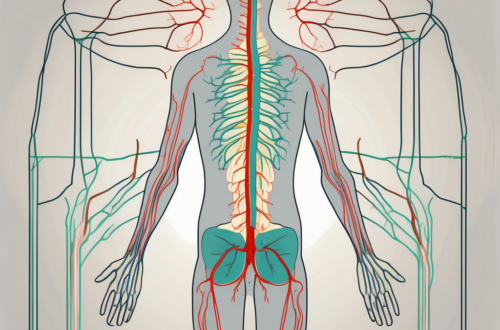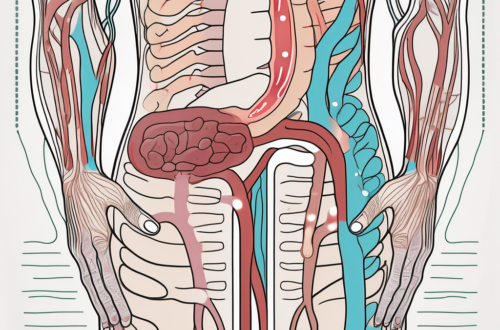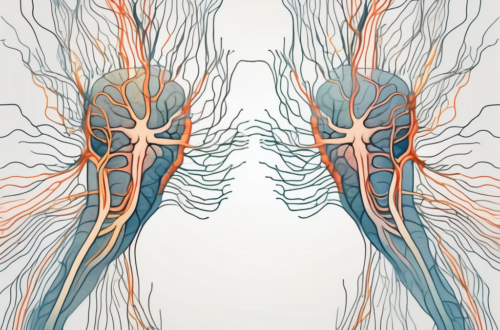The autonomic nervous system is a critical component of the human body, playing a vital role in maintaining physiological balance. Composed of two primary divisions – the sympathetic and parasympathetic nervous systems – this intricate network of nerves regulates various bodily functions, including heart rate, digestion, and response to stress.
Understanding the Autonomic Nervous System
Before diving into the intricacies of the sympathetic and parasympathetic systems, it is essential to grasp the overarching role and function of the autonomic nervous system. Unlike the voluntary control we exert over our skeletal muscles, the autonomic nervous system functions involuntarily, maintaining internal homeostasis independent of conscious thought or effort.
The autonomic nervous system is a complex network of nerves that controls and regulates various bodily functions. It is responsible for maintaining the body’s internal environment, ensuring that all systems work together seamlessly. This intricate system allows for the coordination of vital processes such as cardiovascular regulation, respiratory control, temperature regulation, and glandular secretions.
One of the primary roles of the autonomic nervous system is to facilitate communication between the brain, spinal cord, and numerous organs and glands. This communication is crucial for the body to function properly, as it allows for the transmission of signals and coordination of activities.
Role and Function of the Autonomic Nervous System
The autonomic nervous system encompasses a vast array of physiological processes, each playing a crucial role in maintaining overall health and well-being. For example, cardiovascular regulation ensures that blood flow is appropriately distributed throughout the body, delivering oxygen and nutrients to different organs and tissues. Respiratory control allows for the regulation of breathing, ensuring that the body receives an adequate supply of oxygen and removes carbon dioxide efficiently.
Temperature regulation is another essential function of the autonomic nervous system. It helps maintain a stable body temperature, even in changing environmental conditions. This process involves various mechanisms, such as sweating to cool down the body or shivering to generate heat.
Glandular secretions are also regulated by the autonomic nervous system. This includes the production and release of hormones, enzymes, and other substances that are essential for proper bodily functions. The autonomic nervous system ensures that these secretions are balanced and appropriately timed, allowing for optimal physiological processes.
The Sympathetic and Parasympathetic Divisions
The autonomic nervous system consists of two interconnected divisions – the sympathetic and parasympathetic systems – working in harmonious opposition to maintain equilibrium. These two divisions have distinct anatomical pathways, neurotransmitter systems, and effects on target organs.
The sympathetic division is responsible for the body’s “fight or flight” response, which prepares the body for action in times of stress or danger. It increases heart rate, dilates blood vessels, and redirects blood flow to the muscles, enabling a quick and efficient response. This division also triggers the release of stress hormones, such as adrenaline, to further enhance the body’s readiness.
On the other hand, the parasympathetic division is responsible for the body’s “rest and digest” response, promoting relaxation and conservation of energy. It slows heart rate, constricts blood vessels, and enhances digestion and nutrient absorption. This division helps the body recover and replenish its resources after periods of stress or activity.
These two divisions of the autonomic nervous system work together to maintain a delicate balance in the body. They constantly adjust their activities based on the body’s needs, ensuring that all systems function optimally and that internal homeostasis is maintained.
The Sympathetic Nervous System
The sympathetic nervous system, often referred to as the “fight or flight” response, prepares the body to respond to stressful situations. It is responsible for enhancing physical performance, increasing alertness, and redirecting blood flow to areas essential for immediate survival.
When faced with a perceived threat or danger, the sympathetic nervous system springs into action, mobilizing the body’s resources to either fight off the threat or flee from it. This response is crucial for survival, as it allows the body to quickly respond to potentially life-threatening situations.
The sympathetic pathway originates in the spinal cord’s thoracic and lumbar regions, extending axons to a series of interconnected ganglia. From these ganglia, sympathetic nerves project to target organs, creating a widespread network throughout the body.
These target organs include the heart, lungs, blood vessels, and various glands. When the sympathetic nervous system is activated, it triggers a series of physiological changes that prepare the body for action. For example, the heart rate increases, blood vessels constrict, and airways dilate, allowing for increased oxygen intake.
In the sympathetic system, the primary neurotransmitter is norepinephrine. When released into target organs, norepinephrine stimulates adrenergic receptors, initiating a cascade of reactions that increase heart rate, constrict blood vessels, dilate airways, and mobilize energy stores.
These physiological changes are essential for the body’s immediate response to stress. By increasing heart rate and blood pressure, the sympathetic nervous system ensures that oxygen and nutrients are delivered to the muscles and organs that need them the most during a fight or flight situation.
Furthermore, the sympathetic system also plays a role in regulating other bodily functions, such as digestion and sexual arousal. During times of stress, these non-essential functions are temporarily suppressed, allowing the body to focus its resources on survival.
While the sympathetic nervous system is crucial for survival, prolonged activation can have detrimental effects on health. Chronic stress, for example, can lead to a constant state of sympathetic arousal, which can contribute to various health problems, including high blood pressure, cardiovascular disease, and weakened immune function.
Therefore, it is crucial to understand how to regulate and balance sympathetic activity to maintain optimal physiological well-being. Techniques such as deep breathing exercises, meditation, and regular physical activity can help activate the parasympathetic nervous system, which acts as a counterbalance to the sympathetic system, promoting relaxation and restoration.
In conclusion, the sympathetic nervous system is a vital component of the body’s stress response. It prepares the body for action, enhancing physical performance and redirecting resources to areas essential for immediate survival. Understanding the anatomy, neurotransmitters, and regulation of the sympathetic system can help individuals manage stress and maintain overall well-being.
The Parasympathetic Nervous System
As opposed to the sympathetic system’s role in preparing the body for intense physical activity, the parasympathetic nervous system promotes rest, relaxation, and restoration. It counterbalances the sympathetic system, ensuring that bodily functions return to baseline levels once the stressor has subsided.
The parasympathetic nervous system, also known as the “rest and digest” system, plays a crucial role in maintaining homeostasis in the body. While the sympathetic system prepares the body for fight or flight responses, the parasympathetic system helps bring the body back to a calm and balanced state.
Anatomy of the Parasympathetic Nervous System
In contrast to the thoracolumbar origin of the sympathetic system, the parasympathetic pathway arises from cranial nerves and the sacral region of the spinal cord. Its fibers project to specific target organs, controlling aspects such as digestion, urination, and reproductive functions.
One of the cranial nerves involved in the parasympathetic system is the vagus nerve. This nerve has branches that innervate various organs, including the heart, lungs, stomach, and intestines. These branches release acetylcholine, the primary neurotransmitter of the parasympathetic system.
Neurotransmitters in the Parasympathetic Pathway
In the parasympathetic system, acetylcholine serves as the primary neurotransmitter. Upon release, acetylcholine binds to muscarinic receptors, initiating a range of responses that promote relaxation, efficient digestion, decreased heart rate, and restorative processes.
Acetylcholine acts on various target organs to stimulate their parasympathetic responses. For example, in the digestive system, it enhances the secretion of digestive enzymes and increases blood flow to the gastrointestinal tract, promoting efficient digestion and nutrient absorption.
Function and Regulation of the Parasympathetic System
The parasympathetic system is essential for maintaining overall well-being and ensuring adequate recuperation after stressful events. It helps regulate heart rate, blood pressure, and respiratory rate, promoting a state of calmness and relaxation.
Additionally, the parasympathetic system plays a vital role in sexual arousal and reproduction. It regulates the release of hormones necessary for reproductive functions and promotes the relaxation of smooth muscles in the reproductive organs.
While the parasympathetic system is crucial for maintaining balance in the body, imbalances between sympathetic and parasympathetic activity can arise. Chronic stress, for example, can lead to an overactive sympathetic system and an underactive parasympathetic system, resulting in various health issues.
Seeking professional guidance is crucial to understand and address any potential imbalances in the parasympathetic system. Healthcare providers can provide personalized recommendations and interventions to promote a healthy balance between the sympathetic and parasympathetic systems, ensuring overall well-being and optimal functioning of the body.
Interactions between Sympathetic and Parasympathetic Systems
While the sympathetic and parasympathetic divisions operate separately, they often act in concert to achieve a delicate balance within the autonomic nervous system. This coordination is vital for appropriate responses in different situations, allowing for optimal adaptation to internal and external stimuli.
The interactions between the sympathetic and parasympathetic systems are complex and fascinating. These two divisions of the autonomic nervous system work together to maintain homeostasis, ensuring that the body functions smoothly and efficiently. Let’s delve deeper into the coordination between these systems and explore their impact on overall health.
Sympathetic and Parasympathetic Coordination
The sympathetic and parasympathetic systems work together seamlessly, like a well-choreographed dance. They complement each other’s actions, creating a harmonious symphony of physiological responses. For example, during a stressful situation, the sympathetic system activates to increase heart rate, redirect blood flow, and enhance alertness. This prepares the body for the fight-or-flight response, enabling quick and decisive action.
Once the threat passes, the parasympathetic system takes over, gradually returning the body to its resting state. It slows down the heart rate, relaxes the blood vessels, and promotes digestion and relaxation. This allows the body to recover and replenish its energy reserves.
Imagine a tightrope walker, carefully balancing on a thin wire. The sympathetic system represents the intense focus and concentration needed to maintain balance, while the parasympathetic system represents the calm and relaxation that follow a successful performance. Together, they ensure that the tightrope walker can perform their act flawlessly.
Impact of Imbalance between the Two Systems
An imbalance between the sympathetic and parasympathetic systems can have profound effects on our health and well-being. When one system dominates over the other for an extended period, it can disrupt the delicate equilibrium within the autonomic nervous system.
Chronic sympathetic dominance, where the sympathetic system remains constantly activated, can lead to a range of health issues. The continuous release of stress hormones, such as cortisol and adrenaline, can contribute to cardiovascular disease, high blood pressure, and increased risk of heart attacks. Additionally, sympathetic dominance can impair immune function, making individuals more susceptible to infections and illnesses.
On the other hand, parasympathetic dysfunction can also have detrimental effects on our health. When the parasympathetic system fails to activate appropriately, digestion can be disrupted, leading to issues such as indigestion, bloating, and constipation. Furthermore, a lack of parasympathetic activity can hinder the body’s ability to rest and recover, resulting in chronic fatigue, insomnia, and decreased overall well-being.
Identifying and addressing imbalances between the sympathetic and parasympathetic systems is crucial for maintaining optimal health. This requires professional evaluation and guidance from healthcare providers who specialize in autonomic nervous system disorders. Through a comprehensive assessment, they can determine the underlying causes of the imbalance and develop personalized treatment plans to restore harmony within the autonomic nervous system.
In conclusion, the interactions between the sympathetic and parasympathetic systems are intricate and essential for maintaining homeostasis. Their coordination allows for appropriate responses to various situations, ensuring the body can adapt and thrive. However, an imbalance between these systems can have significant consequences on our health. By understanding the interplay between the sympathetic and parasympathetic systems and seeking professional help when needed, we can strive for optimal well-being and a balanced autonomic nervous system.
Recent Advances in Neurological Research
Advancements in neurological research continue to shed light on the complexities of the sympathetic and parasympathetic nervous systems. Through innovative studies, researchers have made significant breakthroughs, deepening our understanding of nerve pathways and their roles in overall health.
One recent study conducted by a team of neuroscientists focused on investigating the intricate connections within the autonomic nervous system. Using advanced imaging techniques and experimental models, they were able to map out the neural pathways in unprecedented detail. The findings of this study revealed a previously unknown level of complexity and organization within the autonomic nervous system.
Another groundbreaking study in the field of neurological research explored the communication pathways between different regions of the sympathetic and parasympathetic nervous systems. By using cutting-edge technology, the researchers were able to trace the flow of information between these systems, providing valuable insights into how they work together to regulate various bodily functions.
Innovations in Understanding Nerve Pathways
Neuroscientists have made substantial progress in mapping the intricate connections within the autonomic nervous system. Using advanced imaging techniques and experimental models, they have revealed novel insights into the organization and communication pathways of these systems.
One fascinating discovery that emerged from these studies is the existence of multiple parallel pathways within the autonomic nervous system. Previously, it was believed that there was a single pathway for each function controlled by the autonomic nervous system. However, the new research suggests that there are multiple pathways that work in parallel, allowing for more efficient and precise regulation of bodily functions.
Furthermore, these studies have also provided evidence for the existence of cross-talk between different nerve pathways. It appears that certain pathways within the sympathetic and parasympathetic nervous systems can influence each other’s activity, leading to a more integrated and coordinated response to various stimuli.
Future Directions in Neurological Studies
As the field of neuroscience evolves, researchers are pushing boundaries to uncover further intricacies of the autonomic nervous system. By unraveling its mysteries, we can develop targeted interventions and therapeutic approaches to address dysregulations and improve overall well-being.
One promising avenue for future research is the exploration of the role of the autonomic nervous system in various neurological disorders. By understanding how dysfunctions in the autonomic nervous system contribute to conditions such as Parkinson’s disease, multiple sclerosis, and epilepsy, researchers can develop more effective treatment strategies that target the underlying causes of these disorders.
Additionally, there is a growing interest in investigating the impact of lifestyle factors on the autonomic nervous system. Studies have shown that factors such as stress, diet, exercise, and sleep can influence the activity of the autonomic nervous system. By gaining a deeper understanding of these relationships, researchers can provide evidence-based recommendations for promoting optimal autonomic nervous system function and overall well-being.
Conclusion
In conclusion, a comprehensive understanding of the autonomic nervous system, particularly the sympathetic and parasympathetic divisions, is crucial for appreciating the complexity of human physiology. By unraveling the anatomical pathways, neurotransmitters, and functions of these systems, we can appreciate the delicate balance that exists within our bodies. Should you have any concerns regarding your autonomic nervous system’s functioning, it is important to consult with a medical professional who can provide expert evaluation and guidance, ensuring your ongoing well-being.





